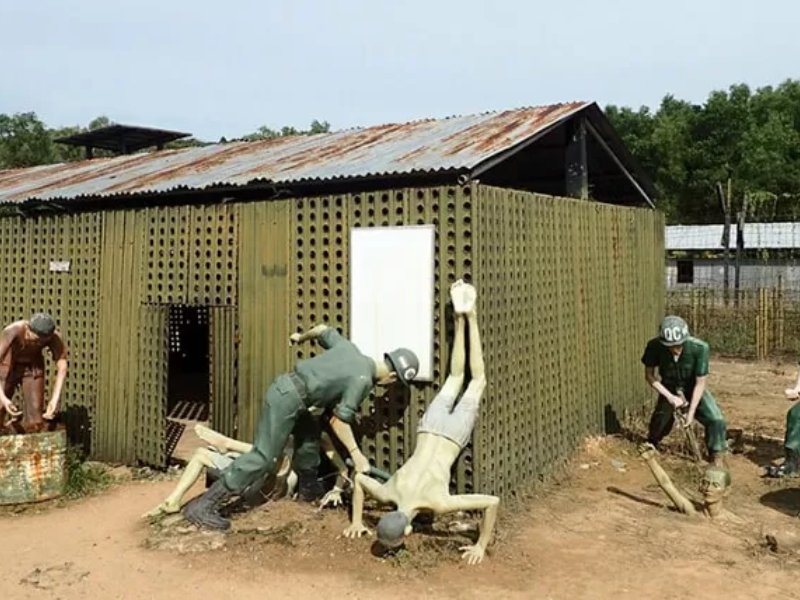Phu Quoc Prison: A Profound Journey Through War History
 ngocdiem
ngocdiem
Explore the poignant history of Phu Quoc Prison, also known as Coconut Tree Prison. This significant site in Vietnam’s war history honors the resilience of prisoners who endured harsh conditions. Visitors can discover its preserved grounds, learn about their experiences, and reflect on important lessons from this dark chapter. A visit to Phu Quoc Prison is essential for anyone looking to understand Vietnam’s past.
1. Introduction
Welcome to our exploration of Phu Quoc Prison, a significant historical site that offers a profound insight into Vietnam’s tumultuous past. Known also as the Coconut Tree Prison, this location stands as a testament to the struggles endured during the Vietnam War. Established in the mid-20th century, Phu Quoc Prison played a crucial role in the conflict, housing many prisoners of war. Its importance in Vietnam’s war history is not just in its function as a detention center but also in the stories and memories it encapsulates.

As we delve deeper into this topic, we will uncover the events that unfolded within these walls and reflect on the broader implications for understanding Vietnam’s journey. The Coconut Tree Prison serves not only as a reminder of the past but also as a call to remember and learn from the lessons of history. Join us as we take this moving journey through the rich tapestry of Phu Quoc war history, highlighting the significance of Phu Quoc Prison and its enduring legacy.
🌟 For more information on Phu Quoc tours and the latest updates, contact us via WhatsApp or visit the Sun Getaways Travel Fanpage. Or follow these posts to get the details if you want to:
2. Historical Background
Phu Quoc Prison was established in the early 1960s, primarily to detain political prisoners and those opposing the government during a tumultuous period in Vietnam’s history. Situated on Phu Quoc Island, the prison was built to hold captured Viet Cong soldiers and suspected communist sympathizers. Its strategic location made it an essential facility during the Vietnam War, highlighting its importance in Phu Quoc war history.

During the Vietnam War, Phu Quoc Prison became infamous for its harsh conditions and brutal treatment of inmates. Reports of torture and inhumane interrogations revealed the grim reality inside. Despite this, many prisoners showed remarkable resilience, with key events including daring escapes and uprisings that highlighted their courage.
One of the most significant incidents involved a mass escape in 1973, where a group of prisoners, using a combination of cunning and determination, managed to flee, showcasing the indomitable spirit of those held captive. This event not only highlighted the desperate conditions inside Coconut Tree Prison but also emphasized the yearning for freedom that characterized the Vietnam War era.
3. Architecture and Layout
- ✨ Description of the Prison Structure:
- 💫 Constructed primarily from concrete and brick.
- 💫 Features small, tightly packed cells designed to house multiple prisoners.
- 💫 The imposing structure serves as a reminder of the oppressive conditions endured by inmates.
- ✨ Unique Features, Including the Coconut Trees:
- 💫 Surrounding coconut trees contribute to the prison’s alternative name: Coconut Tree Prison.
- 💫 The trees provided a vital resource, offering sustenance in the form of coconuts for the prisoners.
- 💫 The presence of coconut trees contrasts sharply with the harshness of prison life, symbolizing resilience and survival.
- ✨ How the Layout Contributed to Its Historical Significance:
- 💫 The design created an environment of isolation, making communication among prisoners difficult.
- 💫 The arrangement of cells and guard towers allowed for maximum surveillance, deterring rebellion or escape.
- 💫 This architectural choice highlights the oppressive nature of the prison, reflecting the broader context of control during the Vietnam War.

By examining the architecture and layout of Phu Quoc Prison, we can appreciate how these elements shaped the experiences of those incarcerated and their enduring spirit amid adversity.
💥 Read more: Discover Phu Quoc Historical Sites: Top Landmarks to Visit
4. Life Inside the Prison
4.1. Daily Life of Prisoners
- ✨ Life inside Phu Quoc Prison was marked by harsh conditions and strict routines.
- ✨ Prisoners were typically confined to their small cells for most of the day, with limited access to fresh air or sunlight.
- ✨ Meals were meager, often consisting of rice and vegetable scraps, leading to malnutrition among inmates.
- ✨ Exercise was rarely permitted, further contributing to both physical and mental deterioration.

4.2. Methods of Interrogation and Treatment
- ✨ Phu Quoc Prison was notorious for its brutal methods of interrogation.
- ✨ Prisoners often faced torture, including physical beatings and psychological manipulation, aimed at extracting confessions or information.
- ✨ The guards employed intimidation tactics, creating an atmosphere of fear that suppressed any attempts at resistance.
- ✨ Many inmates suffered long-lasting trauma due to the inhumane treatment they endured during their time at Coconut Tree Prison.

4.3. Stories of Resilience and Survival
- ✨ Amidst the dire conditions, many prisoners exhibited incredible resilience and strength.
- ✨ Some organized secret groups to support one another, sharing resources and strategies to cope with their circumstances.
- ✨ Notable stories include those of individuals who managed to escape against all odds, using ingenuity and courage to reclaim their freedom.
- ✨ These acts of defiance not only highlighted the prisoners’ fighting spirit but also served as a source of inspiration for future generations in the struggle for justice and liberation.
The daily life inside Phu Quoc Prison was a testament to human endurance in the face of extreme adversity. The methods of interrogation and treatment may have been designed to break the prisoners, but the stories of resilience and survival that emerged from these experiences speak volumes about the strength of the human spirit and the enduring quest for freedom in the context of Phu Quoc war history.
💥 Explore: Top 3 Must-Visit Phu Quoc Waterfalls for Adventure Seekers
5. The Role of Coconut Tree Prison
- ✨ Why It Was Called Coconut Tree Prison:
- 💫 The name Coconut Tree Prison derives from the abundance of coconut trees surrounding the facility.
- 💫 These trees not only defined the landscape of the prison but also served as a notable landmark in the region.
- 💫 The name reflects both the physical environment of the prison and the ironic juxtaposition of beauty and suffering that characterized life within its walls.
- ✨ Symbolism of the Coconut Trees in the Prison’s History:
- 💫 The coconut trees symbolize resilience and survival for the prisoners who found ways to utilize them for sustenance.
- 💫 Despite the oppressive conditions, these trees stood tall, representing hope and endurance amidst despair.
- 💫 The coconuts provided nourishment, reminding inmates of their connection to nature and the possibility of life beyond the prison walls.
- 💫 Additionally, the trees serve as a reminder of the harsh reality of confinement, as they provided a source of food but were also part of the prison’s oppressive atmosphere.
- ✨ How the Location Influenced Its Function During the War:
- 💫 The strategic location of Coconut Tree Prison on Phu Quoc Island made it an ideal site for detaining prisoners during the Vietnam War.
- 💫 Its isolation from mainland Vietnam allowed for tighter security and easier control over the inmates.
- 💫 The surrounding waters and dense vegetation created natural barriers that hindered escape attempts, enhancing the prison’s role as a detention center.
- 💫 This location also facilitated the transfer of prisoners from various conflict zones, consolidating those opposed to the government in one central facility.

💥 Explore: Discover the Best Trails: Mount Chua Hiking Adventure Guide
6. Present-Day Memorial
- ✨ How Phu Quoc Prison Is Preserved Today:
- 💫 Phu Quoc Prison is now a preserved historical site, maintaining its original structure and adding informative displays that educate visitors about its past. The surrounding coconut trees remain, symbolizing resilience amidst the memories of suffering.
- ✨ Visitor Information and What to Expect:
- 💫 Visitors can explore the prison grounds, including former cells and interrogation rooms. Guided tours provide insights into the experiences of the inmates, featuring artifacts and photographs that highlight their stories. The atmosphere encourages reflection on the impact of the Vietnam War.
- ✨ The Importance of Remembering This History:
- 💫 Remembering Coconut Tree Prison is essential to honor those who suffered and to educate future generations about Phu Quoc war history. The memorial fosters empathy and understanding, ensuring the lessons learned are not forgotten, contributing to a more peaceful future.
A visit to Coconut Tree Prison not only offers insight into Vietnam’s history but also emphasizes the importance of remembrance and resilience.

7. Conclusion
Phu Quoc Prison serves as a powerful reminder of resilience and the human spirit’s endurance in the face of oppression. The lessons learned from those who suffered within its walls highlight the importance of standing up for one’s beliefs and recognizing the impact of war on individuals and communities.
Sun Getaways Travel encourage everyone to visit Coconut Tree Prison to learn about Vietnam’s war history firsthand. This experience not only honors the sacrifices made by countless individuals but also fosters a deeper understanding of our shared past. By remembering these events, we inspire future generations to value peace and freedom.
Ask a question
Leave a Comment (0)
No questions yet. Be the first to ask a question!






















